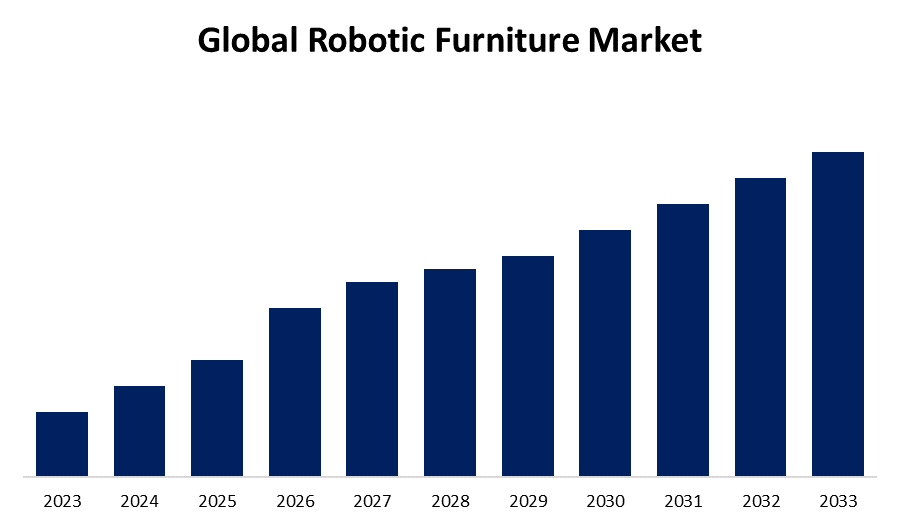Global Robotic Furniture Market Size, Share, and COVID-19 Impact Analysis, By Type (Beds & Wall Beds, Tables, Sofas & Chairs, Others), By Sales Channel (Online, Offline), By End User (Residential, Commercial), and By Region (North America, Europe, Asia-Pacific, Latin America, Middle East, and Africa), Analysis and Forecast 2023 – 2033
Industry: Consumer GoodsGlobal Robotic Furniture Market Insights Forecasts to 2033
- The Market is Growing at a CAGR of XX% from 2023 to 2033
- The Worldwide Robotic Furniture Market Size is expected to Hold a Significant Share by 2033
- Asia Pacific is expected to Grow the fastest during the forecast period

Get more details on this report -
The Global Robotic Furniture Market Size is expected to hold a significant share by 2033, at a CAGR of XX% during the forecast period 2023 to 2033.
Robotic furniture is automated, adaptable furniture that allows consumer to make better use of their living spaces. Transformable furniture, which is still widely used and well-liked, used to require manual operation. The robotics furniture is often left in its current state if the transformation is laborious or requires physical effort. Digitally movable furniture is an advancement of this trend that provides a simple and quick way to change. Furthermore, one-bedroom residential apartments can be transformed into multipurpose spaces with the help of robotic furniture. With only a few buttons clicks, a bedroom, living room, or dining area can be transformed into an office or other space due to its automation, adaptability, and adjustment capabilities. Electronic, mechanical, and technological systems are all incorporated into robotic furniture. The furniture retracts or rolls around on wheels, and the robotic component uses machine learning to move the piece across the living area or floor. However, the USA, Hong Kong, and Japan are the only retail locations for this high-tech robotics furniture, which has only recently been released. Thus, such factor is boosting the market growth in the forecast period.
Global Robotic Furniture Market Report Coverage
| Report Coverage | Details |
|---|---|
| Base Year: | 2033 |
| Market Size in 2033: | USD XX Billion |
| Forecast Period: | 2023-2033 |
| Forecast Period CAGR 2023-2033 : | XX% |
| 2033 Value Projection: | USD XX Billion |
| Historical Data for: | 2019-2022 |
| No. of Pages: | 200 |
| Tables, Charts & Figures: | 120 |
| Segments covered: | By Type, By Sales Channel, By End User, By Region and COVID-19 Impact Analysis. |
| Companies covered:: | IKEA, Bumblebee-The Space Company, Clei, Airbnb, Oris, KEENON Robotics, Daesung Industrial Co., Ltd, iRobot Corporation and Other Key Vendors. |
| Pitfalls & Challenges: | COVID-19 Empact, Challenge, Future, Growth, & Analysis |
Get more details on this report -
Driving Factors
Robotic furniture is multifunctional and can transform a limited space into a versatile space with the click of a button, whether it's a bedroom, an office, or a kitchen. When someone works from home, robotic furniture makes it easy for them to transform their cozy living space into a formal office. It is generally harder to focus when working from home in a smaller space. This situation can be changed by using robotic furniture, which can make a small space easier, more functional, and presentable for work. Furthermore, people in countries such as Japan and Hong Kong live in homes as small as 160 square feet. These individuals stand to gain a great deal from robotic furniture because it is constructed with a machine learning system that maps out the image of the home and produces shape-shifting furniture to fit the available space. This furniture can then be easily converted into multipurpose areas. Such factors are boosting the market growth in the forecast period.
Restraining Factors
The majority of equipment manufacturers use proprietary interface protocols for communications, which makes the lack of technology standardization more difficult to integrate.
Market Segmentation
By Type Insights
The beds & wall beds segment dominates the market with the largest revenue share over the forecast period.
On the basis of type, the global robotic furniture market is segmented into beds & wall beds, tables, sofas & chairs, and others. Among these, the beds & wall beds segment is dominating the market with the largest revenue share over the forecast period. A beds & wall beds furniture is a useful asset that provides a place to relax and unwind during the day and a comfortable, compact sleeping area at night. This furniture is incredibly practical and is available in several versions with integrated storage. Its two benefits make it a useful addition to any home, and those looking to expand their living area are drawn to it.
By Sales Channel Insights
The offline segment is witnessing significant CAGR growth over the forecast period.
On the basis of sales channel, the global robotic furniture market is segmented into online, and offline. Among these, the offline segment is witnessing significant growth over the forecast period. Offline channels provide instant gratification and satisfaction. Offline shopping eases the financial strain of making a purchase. These provide precise details regarding the weight and dimensions of the product and also lessen the issue of low stock. The dimensions of the room as the foundation for selection criteria when selecting smaller items, such as study tables, chairs, etc. It frees up space while assisting in choosing the ideal product.
By End User Insights
The residential segment is expected to hold the largest share of the global robotic furniture market during the forecast period.
Based on the end user, the global robotic furniture market is classified into residential, and commercial. Among these, the residential segment is expected to hold the largest share of the global robotic furniture market during the forecast period. Robotic furniture is multipurpose and can instantly transform a small space, like a bedroom, office, or kitchen, into a versatile area with just a single button push. When someone works from home, robotic furniture makes it easy for them to transform their cozy living space into a formal workspace.
Regional Insights
North America dominates the market with the largest market share over the forecast period.

Get more details on this report -
North America is dominating the market with the largest market share over the forecast period. As more Americans do work from home, technology companies want to make homes work harder for their occupants. With the push of a button, people can now convert residential spaces into multiple uses through robotic furniture. Over a decade ago, the Brooklyn-based startup Ori started experimenting with residential spaces. The company makes "expandable apartments," meaning that a queen-size bed can be raised to reveal a couch or a media centre can be slid to reveal a home office.
Asia Pacific is expected to grow the fastest during the forecast period. The robotics furniture sales in countries such as China as a result of high demand in the automotive sector and the effects of the US-China sales. APAC is still predicted to have the fastest market growth during the forecast period, with China expected to recover in the forecast years. Manufacturers in APAC are being forced to automate in order to preserve their cost advantage due to rising labor costs.
List of Key Market Players
- IKEA
- Bumblebee-The Space Company
- Clei
- Airbnb
- Oris
- KEENON Robotics
- Daesung Industrial Co., Ltd
- iRobot Corporation
- Others
Key Market Developments
- On January 2024, Leading manufacturer of consumer robots, iRobot Corporation announced that it will undertake an operational restructuring plan aimed at positioning the business for stabilization in the current climate, with a focus on profitability and the advancement of important growth initiatives to increase market share in the mid-tier and premium segments. After iRobot and Amazon mutually decided to end their previously announced merger agreement, this plan was approved.
Market Segment
This study forecasts revenue at global, regional, and country levels from 2020 to 2032. Spherical Insights has segmented the global Robotic Furniture market based on the below-mentioned segments:
Robotic Furniture Market, Type Analysis
- Beds & Wall Beds
- Tables
- Sofas & Chairs
- Others
Robotic Furniture Market, Sales Channel Analysis
- Online
- Offline
Robotic Furniture Market, End User Analysis
- Residential
- Commercial
Robotic Furniture Market, Regional Analysis
- North America
- US
- Canada
- Mexico
- Europe
- Germany
- Uk
- France
- Italy
- Spain
- Russia
- Rest of Europe
- Asia Pacific
- China
- Japan
- India
- South Korea
- Australia
- Rest of Asia Pacific
- South America
- Brazil
- Argentina
- Rest of South America
- Middle East & Africa
- UAE
- Saudi Arabia
- Qatar
- South Africa
- Rest of Middle East & Africa
Frequently Asked Questions (FAQ)
-
1. What is the market size of the global Robotic Furniture Market?The Global Robotic Furniture Market is expected to grow from USD XX billion in 2023 to USD XX billion by 2033, at a CAGR of XX% during the forecast period 2023-2033.
-
2. Which region is dominating the global robotic furniture market?North America is dominating the global robotic furniture market.
-
3. Which are the key companies in the market?IKEA, Bumblebee-The Space Company, Clei, Airbnb, Oris, KEENON Robotics, Daesung Industrial Co., Ltd, iRobot Corporation, and Others
Need help to buy this report?